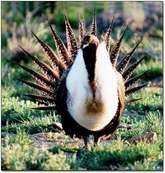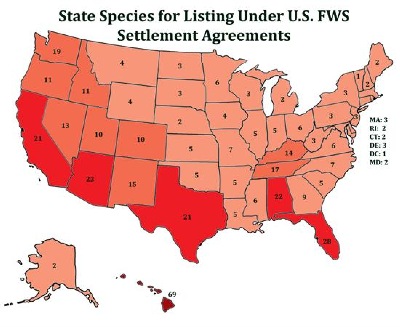

 |
 |
 |
 |
 |
 |
 |
 |
 |
 |
 |
 |
 |
 |
 |
 |
 |
Secretary Zinke Signs Secretarial Order 3353 to Improve Sage-Grouse Conservation, Strengthen Communication and Collaboration Between States and Feds Posted June 22, 2017
Excerpt from the Federal Register and BLM Conservation Planning Map - June 2014 SAGE GROUSE WILL ACCOMPLISH
All this taxpayer expence for a bird.
Greater Sage Grouse public land issue could close access to hundreds of collecting sites in the States of Washington, Oregon, California, Idaho, Nevada, Montana, Wyoming, Colorado, Utah, Arizona and New México. If the Greater Sage Grouse becomes listed as an Endangered Species, then a lot of their habitat will be closed to human access.
What sets the sage grouse issue apart from other Endangered Species is the size of the habitat. To this day, nobody knows how many acres of public, state and private lands will be designated as "critical habitat" but the figure is staggering. Millions upon millions of sagebrush grassland habitat could be affected.
Sage Grouse Issue Update by the BRC Latest information as of November 2013
Sage grouse is becoming Utah’s spotted owl
Records of Decision: Nevada and California Greater Sage-Grouse Bi-State Distinct Population Segment Land Use Plan Amendment (PDF) May 26, 2016 Press Release - September 13, 2012 - Congressman Mark Amodei (NV-2) criticizes BLM for using sage hen to block energy development. "Governor creates new Sage Grouse Advisory Committee" (Reno Gazette-Journal, 4/12/12) More on BLM, Nevada and the Greater Sage-gouse
In July, the Obama Administration agreed to settlements with the Center for Biological Diversity and the WildEarth Guardians that covered petitions to list 779 species and 85 lawsuits and legal actions. These settlements mandate that over 250 candidate species must be reviewed for final listing as either threatened or endangered under the ESA by 2016. As shown on the map below, the settlements could increase the number of species listed in all 50 states, a total increase of 16% by 2016. According to the Fish and Wildlife Service’s FY 2013 budget request, as part of the settlement, 88 new final and 47 proposed listing determinations are projected to be completed during this fiscal year.
More Information from the Natural Resources Committee | ||





 Don't let the Greater Sage Grouse become another Spotted Owl.
Don't let the Greater Sage Grouse become another Spotted Owl. 


 See how many new endangered species may be added in your state. These could have an impact on gaining access to your collecting sites. Note: California has more Threatened and endangered species listed than any other state.
See how many new endangered species may be added in your state. These could have an impact on gaining access to your collecting sites. Note: California has more Threatened and endangered species listed than any other state.